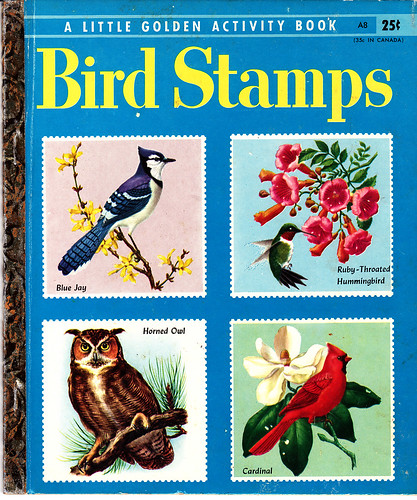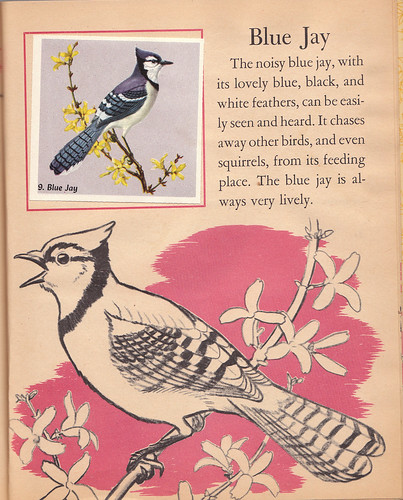Before we left, my dad told us we were going to take a vacation in the country. I was skeptical, because that’s also what he’d said before we moved from the city to our blue-collar suburb. To me, going to the country was supposed to mean that you could see cows, and there were no cows at all in Northlake. But this time my dad was right—on the way to Lake Geneva, we really did see cows!
Of course right in Williams Bay, there were no cows, and the cottages were more closely spaced than the houses in my blue-collar suburb. I was hoping to see more birds than I’d seen in Northlake so far. I didn’t have binoculars—my mother had told me that only soldiers, spies, and peeping toms had those—and I didn’t know how to search through branches to find birds anyway.
But one morning I heard a squawk, looked up, and lo and behold, there was a Blue Jay! I saw the exquisite plumage and the extraordinary crest, and knew exactly what it was, because the Blue Jay was one of the 18 birds in my “Golden Activity Book,” Bird Stamps. And not just any bird in the book—it was the very first bird depicted on the cover. I had so longed to see one, and now, here he was, yelling his head off, seemingly just as pleased to make my acquaintance as I was to make his.
Almost 60 years later, the thought of that moment is still seared into my memory. I never saw another Blue Jay throughout my entire childhood—the next one I saw was on March 23, 1975, in Lansing, Michigan, three weeks after I started birding—it was #14 on my lifelist. That one was pretty wonderful, but something in my throat, and in my heart, still seems to catch when I think of my very first Blue Jay. When I remember the thrill and elation I felt, the joyous sense of accomplishment that I’d identified it all by myself from my precious Bird Stamps book from my Grandpa, the vividness of its plumage and exuberance of its call—all this gives me a sense of certainty that that Blue Jay was my Best Bird EVER! ™ (I'm going to pretend I have an actual trademark on this phrase.)
Since that memorable day so long ago, I’ve seen over 2,000 species, including a few of the rarest birds on the planet, such as the California Condor and Horned Guan; some of the most spectacular ones, such as the Cuban Tody and Resplendent Quetzal; some birds with the coolest sounds, such as the Willow Ptarmigan and Winter Wren. I’ve seen birds at moments when I desperately needed a beautiful natural interlude, such as the four Buff-breasted Sandpipers that appeared like a vision on my first walk after my father’s funeral, or the Evening Grosbeak flock that Russ and I awoke to the morning after his first painful night at home from the hospital after cancer surgery. Russ had loved Evening Grosbeaks since we moved to Duluth—they were always in the yard as our children played—and now they provided balm to his soul and mine for the next five weeks, a constant presence in our yard right when we needed them most. That flock was definitely the Best Birds EVER! ™
And that’s exactly the thing about the Best Bird EVER! ™ Whether it’s an individual bird or a whole flock, it stirs your soul in a way you'll never forget. That very first Blue Jay in Lake Geneva was the first of many Best Birds EVER! ™ for me. It wasn’t even the last Blue Jay among those memorable birds, either.
The one thing rarer than a blue moon is a month without any full moons at all, which February 2018 was. That means that even though it was National Blue Jay Awareness Month in January, we’re starting another National Blue Jay Awareness Month today, because like January, March will also have a blue moon. So this month I’m starting a personal project called Laura’s Best Bird EVER! ™ In upcoming programs, I’ll feature several more individual Blue Jays that managed to touch my soul in deeply spiritual or magical ways. And I'll talk about a few Best Birds EVER! ™ that aren't jays at all. National Blue Jay Awareness Month won’t come again until October 2020, so I plan to enjoy this special one while I can.


